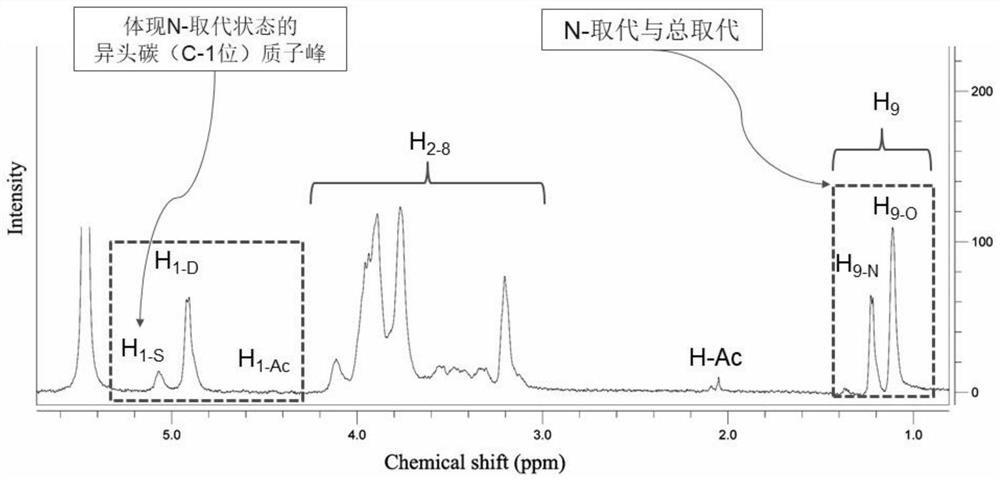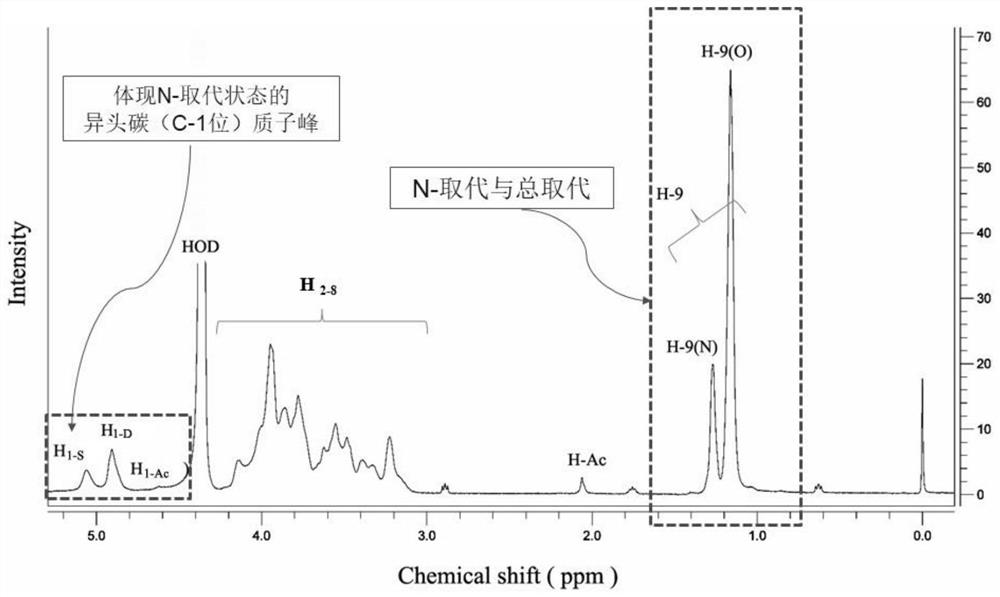A method for measuring n-degree of substitution, total degree of substitution and degree of acetylation of hydroxypropyl chitosan
A technology of hydroxypropyl chitosan and hydroxypropyl, applied in the research and application field of hydroxypropyl chitosan, can solve the problems of small integral measurement value, inability to measure single peak, overlapping characteristic peaks, etc.
- Summary
- Abstract
- Description
- Claims
- Application Information
AI Technical Summary
Problems solved by technology
Method used
Image
Examples
Embodiment 1
[0053] Reagent: The sample of hydroxypropyl chitosan is self-made in the laboratory, with shrimp chitosan (deacetylation degree is 92.0%, prepared by 1 HNMR measured) as the raw material, prepared according to Peng's method "Preparation and antimicrobial activity of hydroxypropyl chitosan, Carbohydrate Research, 2005, 340:1846-1851".
[0054] Instrument: DD2500Mhz nuclear magnetic resonance instrument Agilent Technologies Co., Ltd.
[0055] experimental method:
[0056] A method for measuring the degree of substitution of hydroxypropyl chitosan, comprising the following steps:
[0057] (1) Preparation of hydroxypropyl chitosan samples
[0058] a. Dry the hydroxypropyl chitosan sample to remove moisture. The specific operation is: weigh 8mg of the hydroxypropyl chitosan sample in a centrifuge tube, dry it at 80°C for 4-5 hours, then raise the temperature to 105°C until dry to constant weight. After drying, open the oven and seal it immediately, and place it in a desiccator ...
Embodiment 2
[0087] Reagent: The sample of hydroxypropyl chitosan is self-made in the laboratory, and shrimp chitosan (the degree of deacetylation is 94.9%, prepared by 1 HNMR measured) as the raw material, prepared according to Peng's method "Preparation and antimicrobial activity of hydroxypropyl chitosan, Carbohydrate Research, 2005, 340:1846-1851".
[0088] Instrument: Pro pulse 500MHz Agilent
[0089] experimental method:
[0090] A method for measuring the degree of substitution of hydroxypropyl chitosan, comprising the following steps:
[0091] (1) Preparation of hydroxypropyl chitosan samples
[0092] a. Dry the hydroxypropyl chitosan sample to remove moisture. The specific operation method is: weigh 8mg of the hydroxypropyl chitosan sample in a centrifuge tube, dry it at 80°C for 4-5 hours, and then raise the temperature to 105°C until Dry to constant weight. After drying, open the oven and seal it immediately, and place it in a desiccator to cool for later use;
[0093] b. A...
Embodiment 3
[0121] Reagent:
[0122] Reagent: The sample of hydroxypropyl chitosan is self-made in the laboratory, and shrimp chitosan (the degree of deacetylation is 92.9%, prepared by 1 HNMR measured) as the raw material, prepared according to Peng's method "Preparation and antimicrobial activity of hydroxypropyl chitosan, Carbohydrate Research, 2005, 340:1846-1851".
[0123] Instrument: JNM-ECP 600MHz nuclear magnetic resonance instrument, Japan Electronics Co., Ltd.
[0124] experimental method:
[0125] A method for measuring the degree of substitution of hydroxypropyl chitosan, comprising the following steps:
[0126] (1) Preparation of hydroxypropyl chitosan samples
[0127] a. Dry the hydroxypropyl chitosan sample to remove moisture. The specific operation method is: weigh 7.5mg of the hydroxypropyl chitosan sample in a centrifuge tube, dry it at 80°C for 4-5 hours, and then heat up to 105°C. until dry to constant weight. After drying, open the oven and seal it immediately, a...
PUM
 Login to View More
Login to View More Abstract
Description
Claims
Application Information
 Login to View More
Login to View More - R&D
- Intellectual Property
- Life Sciences
- Materials
- Tech Scout
- Unparalleled Data Quality
- Higher Quality Content
- 60% Fewer Hallucinations
Browse by: Latest US Patents, China's latest patents, Technical Efficacy Thesaurus, Application Domain, Technology Topic, Popular Technical Reports.
© 2025 PatSnap. All rights reserved.Legal|Privacy policy|Modern Slavery Act Transparency Statement|Sitemap|About US| Contact US: help@patsnap.com



